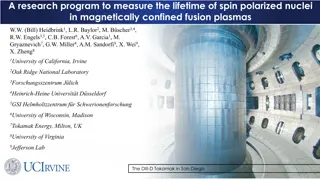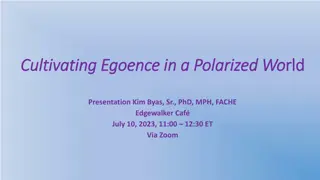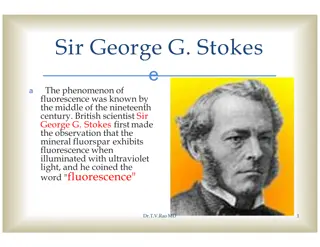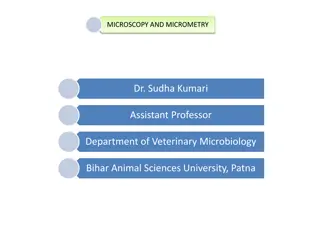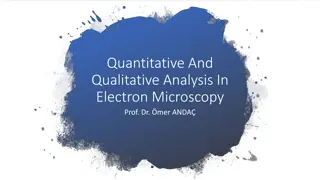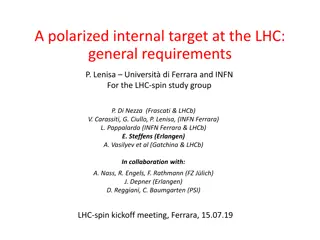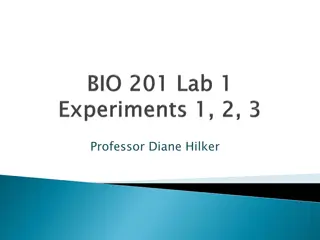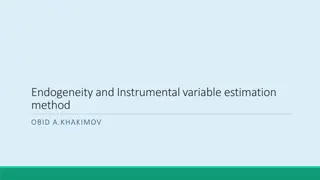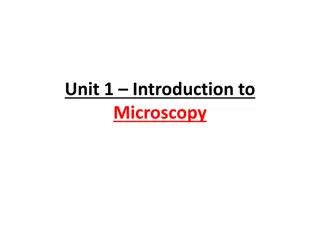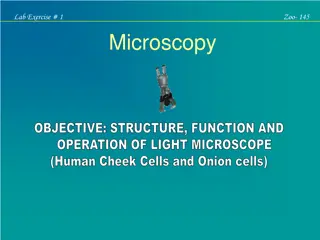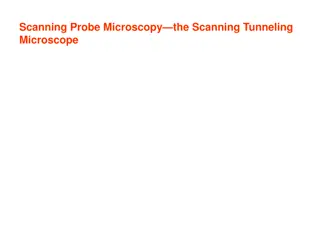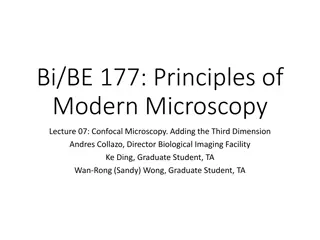Understanding Polarized Light Microscopy in Instrumental Analysis
Microscopes are essential tools for examining small details in samples. Polarized Light Microscopes (PLM) use polarized light to enhance image quality and study birefringent materials. This article covers the basics of microscopes, the principles of PLM, the differences between PLM and LM, and the advantages and drawbacks of image analysis. It also delves into the behavior of isotropic and anisotropic materials in PLM systems.
Download Presentation

Please find below an Image/Link to download the presentation.
The content on the website is provided AS IS for your information and personal use only. It may not be sold, licensed, or shared on other websites without obtaining consent from the author. Download presentation by click this link. If you encounter any issues during the download, it is possible that the publisher has removed the file from their server.
E N D
Presentation Transcript
FE 315 Instrumental Analysis Image Analyzing with Polarized Light Microscope 1
CONTENT What is Microscope ? What is Polarized Light Microscope (PLM) ? What are the most important parts of the PLM? Placement of polarizer and analyzer on PLM Application of PLM What is the difference between LM and PLM? Some advantages and drawbacks of image analyzing 2
What is Polarized Light Microscope (PLM)? - Polarize light microscopy is a technique involving polarized light for illumination of the sample, while blocking the directly transmitted light with a polarizer. - PLMs have a high degree of sensitivity and can be utilized for both quantitative and qualitative studies at a wide range of birefringent materials. 4
- Singly refracting: Materials that fail to polarize transmitted light are said to be SINGLY REFRACTIVE (Some gemstones, such as opal, garnet and spinel, are singly refractive, and they have only - Doubly refracting (birefingent): Double refraction, also called birefringence, an optical property in which a single ray of unpolarized light entering an anisotropic medium is split into two rays, each traveling in a different direction one refractive index). 5
Isotropic & Unistoropic material behavior in PLM system 6
What are the most important parts of the PLM? 7
When transmission obtained. using polarizers, and there area-background is no light dark is Any selecting from natural (unpolarized) white light is now referred to as a polar or polarizer. device capable polarized of light 9
Application of PLM PLM involves to study in detecting, identifying, classifying, measuring and evaluating the significance of physical and cultural materials, their patterns and spatial relationship. The technique can be used both qualitatively and quantitatively in the material sciences, geology, chemistry, medicine and food analysis. biology, metallurgy, 11
Optical micrograph (OM) vs Polarize light micrograph (PLM) Observations: OM: the content of the corn dust is greater than that of the soybean dust (Qualitative) PLM: amounts of starch is 43.5% for corn and 27.4% for soybean. (Quantitative) *These percentages were calculated total area of starch particles divided by total area particles. starch Relative as of 12
What is the difference between LM and PLM? The polarizing microscope is used mainly in geological studies for geological specimens but also in medicine and biology. This type of microscope differs from the normal one by using a polarized light, in which the light waves vibrate in one direction. 13
Polarized Light Image Analyzing Advantages quick and objective operation, consistency, efficiency and cost effectiveness, reduction of tedious human involvement, automation of many labor intensive processes, Disadvantages need for defined and consistent lighting, calibration requirements; the difficulties encountered with overlapping objects when both sides of a food need to be evaluated. 14
Experiment: Learning the sample analysis on optical and polarized light microscope Collect the data as indicated on Table 1. Calculate percent gelatinization (% cooked). Draw a calibration curve by comparing cooked starch % versus cooking time using cooking data. Standard deviation and a linear model will be derived. Table 1. Starch gelatinization during cooking at 85oC (1 cm=239.73 pixels) 15
Calculation and Discussion Find the Unknown Cooking Time with the calibration curve, comment a little on the degree of gelatinization. Give some more information and application samples about PLM in discussion part. Group and printed report, 1 week time. Good Luck =) 16


